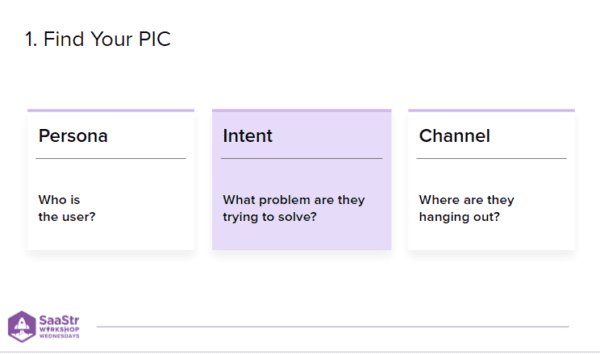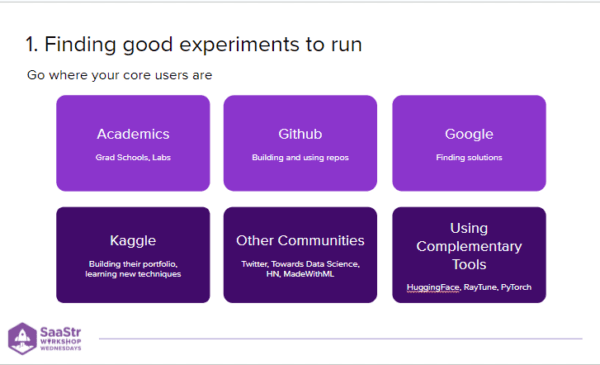A Simple Framework for Exponential Growth at Scale for Technical Buyers with Weights & Biases VP of Growth Lavanya Shukla
"Teach people something new, make it easy for them to keep up with what’s going on in the industry, and connect them with their mentors and heroes."
Startups only have a limited amount of resources with an unlimited amount of experiments they can try. So, how do growth teams discover and prioritize those resources most effectively?
In last week’s episode of Workshop Wednesday, held every Wednesday at 10 a.m. PST, Lavanya Shukla, VP of Growth at Weights & Biases, shared a data and experimentation-driven approach to creating exponential growth systematically.
For some context on the company, Weights & Biases is an AI developer platform to help train and deploy all Machine Learning models. It was founded by three very technical founders.
The framework Lavanya’s team uses is called F.U.E.L., and it’s general enough to help any startup think through growth problems and bottlenecks.
F — Flywheels
U — Users
E — Experiments
L — Learnings
In this article, we’ll talk about:
The importance of understanding user decisions behind every metric you want to move and how to inspire those decisions.
Running data-driven experiments to influence those decisions.
Capturing learnings from those experiments and converting them into playbooks.
Feeding all of the above back into the flywheel to do again and again.
F: Flywheels
You want to build flywheels, not funnels. Funnels lead to linear growth.
They generate awareness, the user gets more engaged in the product, etc.
But with flywheels, you add an extra step where you take the most engaged users and turn them into champions for you.
You do that by getting them to build publicly on top of your product.
A good example of this is Github. People are building and sharing with people, which draws in more people who sign up.
That’s Weights & Balances’ North Star in this market.
They don’t want to pay for users or linear growth. They want exponential growth.
Two Main Flywheels
There are two main flywheels for many startups, especially very technical ones.
Content
Organic search
Machine Learning engineers write about the latest models and papers and share the performance within the Weights & Biases platform.
You want blog posts that are interactive and valuable to people.
If you can get users to write content and distribute it through social media, you’ll draw in even more users.
Organic search is the most significant way people learn about Weights and Biases.
Users are searching for solutions to their problems, so they have high intent and often become engaged users for a long time when they find content that helps them solve their problems.
Set a North Star Metric
Be really obsessive about measuring your North Star metric.
Weights & Biases created a culture of reporting on these metrics every single week.
Be honest about these numbers, and hire people who are honest and curious about why there are bottlenecks in the funnel and are committed to finding the answer.
What makes a good North Star metric?
There are three components to creating good North Star metrics.
Figure out who the user is.
The most valuable users, their titles, whether it’s a technical or buyer persona, what deployment they’re using, etc.
Determine what the minimum viable activity is to be considered a user.
This should be valuable and require a certain amount of effort from users. Someone liking your blog post doesn’t count. Someone writing one does.
Determine the cadence in which users should be active.
If the product is Slack, users need to be using it daily. For tax software, maybe it’s once every six months. What’s frequent enough in your product to become a habit of using it?
This is a process that you iterate over time.
Start Measuring Everything Now
You need to start measuring as soon as possible, and every single step and action in your entire funnel should be instrumented.
If you aren’t measuring, you aren’t learning.
Teams should also focus on fixing attribution so you can trust your data.
Someone watching a YouTube video and then signing up for your product is harder to attribute than someone searching for your website and filling out a form.
Make sure you have the full picture, even if you’re small now and don’t care.
Future investors will care about the ROI of your expenses.
U: Users
The next step in this framework for exponential growth is to find your PIC.
Find Your PIC
You need to understand your persona, intent, and distribution and have a fit or alignment across them.
Persona — who the user is
Intent — what problem you’re trying to solve
Distribution channel — where they’re hanging out
If you’re trying to get users through social media, it’s very different content than through an event or organic search.
All experiments should have a clearly defined persona, intent, and channel before developing the content.
Below is a look at Weights & Biases personas.
Behind Every Metric You Want to Move is a Decision You Want the User to Make
Your job is to understand the decisions made at each step of the funnel.
You want to make it insanely easy for the user to make that decision.
Ask yourself these questions to determine if it’s easy to take that next step…
Would I take this action if I didn’t care about this company?
Would I sign up or come back another day?
If not, reduce the cognitive load or give potential users more motivation to get through that next step.
E: Experiments
There are two types of experiments you want to run.
Optimizing existing channels
Finding new channels
You want to run experiments in both buckets.
Finding Good Experiments to Run
You need to go where your core users are.
It’s hard to get users to build new habits, but if you integrate into places they already are, it’s easier to get them to tack on the habit of using your product.
Weights & Biases went to places where ML engineers were hanging out at scale — like schools.
When coming up with experiments, take advantage of what your audience is interested in and excited about.
Another aspect of experiments is community building.
Build a community.
Community-led growth is the most underappreciated way to grow, especially for technical audiences.
Teach people something new, make it easy for them to keep up with what’s going on in the industry, and connect them with their mentors and heroes.
How to Run Experiments
You have a limited amount of time and resources as a startup with an infinite amount of things to try.
When you’re running experiments, ensure you have:
Clear start and end dates for the experiment.
Clear attribution that you can measure. If you can’t measure it, don’t do it.
Clear metrics of success that require some amount of effort from the user.
A portfolio of experiments ranging from high impact and effort to medium to low impact and effort.
Experiments should have short iteration cycles of no more than two weeks.
If you aren’t changing something every two weeks, you’re taking too long. You can have experiments running for more than two weeks but iterate often to test what is and isn’t working.
You must also kill your darlings, as Stephen King says. Don’t be afraid to kill what doesn’t work, and do so super fast.
Build a culture where people aren’t afraid to try things.
It’s ok for experiments to fail. It’s not ok for experiments to fail without learning something.
L: Learnings
The real output of a growth team isn’t just user or pipeline growth. It’s building a machine that leads to scalable, repeatable growth.
Over time, you want to get so good at running experiments that you can closely predict that if you do X, you’ll get 100 or 1,000 users.
Capture those learning of why something does or doesn’t work and create playbooks out of it.
How to Build a Growth Team
Building a growth team in a technical environment doesn’t require people experienced in marketing or growth.
Instead, look for the traits in the image above.
Data-driven and creative
Only hire people who know your user inside and out
Look for people who care about building in public
You need great writers or speakers — ideally, both
Gumption, grit, honesty, and curiosity mean you’ll have a team that can break through walls
In a growth team, you want to find people who see a problem and solve it. You don’t need to hire marketing people.
Hire someone just like your users who is public-facing. Talk to them about strategy and prioritization constantly.
Keep Updating Those Playbooks
For a technical business, you have to have something about the product that allows users to build something publicly to do the flywheel here.
Not every technical person wants to write content, but some are motivated to teach people.
Hire those people.
And, it’s not enough just to write a blog post, but how to convert readers to users from a blog post.
The playbook is constantly changing, so a growth team requires adaptability, curiosity, and a willingness to get in the weeds and get creative.










